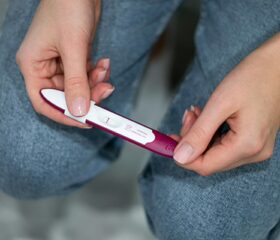Listeria in Pregnancy: Symptoms, Causes, & Prevention
When you’re pregnant, there are plenty of dos and don’ts when it comes to food. One of the top concerns is exposure to listeria—a bacteria that can cause a dangerous infection called listeriosis.

While it’s rare, listeriosis can have serious consequences for you and your baby. Let’s look at what, exactly, listeria is, the symptoms of listeriosis, and how you can prevent it.
What are listeria and listeriosis?
Listeria monocytogenes is a kind of bacteria found in soil, water, and even sewage that causes listeriosis. 1 It can contaminate various foods, particularly ready-to-eat or refrigerated items.
Many healthy adults don’t notice when they’re exposed to listeria, but listeriosis can be much more serious during pregnancy. 2
During pregnancy, you’re 10 times more likely to get listeriosis than the general population. In fact, a full 16%–27% of listeria infections occur in pregnant women. 3 4 Since your immune system changes during pregnancy, it’s harder for your body to fight infections.
Hispanic pregnant women may be more at risk of listeriosis
Hispanic pregnant women may face an even greater risk of listeriosis—up to 24 times higher. This could be due to dietary habits like consuming unpasteurized cheeses and milk or a statistically higher likelihood of having limited access to healthcare. 5
What are the risks of listeriosis during pregnancy?
Listeria can enter your bloodstream and cross into the placenta. This puts your baby at risk of getting infected. 6 Even if you have mild or no symptoms yourself, your body can still transmit the bacteria to your baby. 7
Listeriosis can lead to miscarriage and may also cause severe complications like: 8
- Preterm labor and delivery
- Stillbirth
- Blood infection or meningitis
- Long-term effects, including intellectual disability, seizures, and paralysis
- Organ damage causing blindness, brain, kidney, or heart problems
In some cases, your baby can develop late-onset listeriosis, where symptoms appear weeks after birth due to infection during labor or delivery. 9
All of that sounds alarming, and it’s good to take it seriously, but fortunately, even if you contract listeriosis, there’s no guarantee that you’ll transmit it. Your doctor can treat you with antibiotics to help prevent the infection from reaching your baby. 10
What are the symptoms of listeriosis?
It can take between a week and two months for signs of listeriosis to appear. The symptoms may mimic the flu or a mild cold, and may include: 11
- A fever over 100.6°F (38.1°C)
- Muscle aches
- Fatigue
- Headaches
- Nausea with vomiting or diarrhea
If you’re pregnant and experience any of these symptoms, especially after eating high-risk foods, call your doctor immediately. 11
What to do if you suspect listeria exposure
First of all, don’t panic. Since many of the listeriosis symptoms mimic those of milder infections, it’s possible you don’t actually have it.
Again, just get in touch with your doctor and keep an eye on your symptoms. Your doctor will check for listeria if infection is suspected. 10
If your doctor diagnoses you with listeriosis, they may give you antibiotics to prevent the infection from reaching your baby. They might also order extra fetal testing to monitor your baby’s health and growth.
After you give birth, your baby may be tested, and will be treated as needed. 10
How to minimize the risk of listeria exposure during pregnancy
While it’s understandable to be scared about listeriosis, you can prevent it with smart food choices.
Cut the following high-risk items from your pregnancy diet unless they’re cooked or treated to kill bacteria. Some of the riskiest foods include: 12
- Deli meats and hot dogs: Pregnant women can eat hot dogs, pepperoni, and other processed meat if they’re reheated to 165°F (steaming hot) first.
- Soft cheeses: Avoid Brie, feta, Camembert, blue-veined, or Mexican-style cheeses. However, you can safely eat cheese while pregnant if it’s made from pasteurized milk.
- Refrigerated smoked seafood: Includes lox and nova-style salmon unless cooked. Canned versions are safe.
- Unpasteurized milk and juices: Always choose pasteurized products.
- Raw sprouts: Skip alfalfa, radish, and clover sprouts.
- Prepared deli salads: Be especially careful about avoiding those with egg, chicken, or seafood. Never eat them if they’ve been sitting at room temperature for more than 2 hours.
- Improperly prepared melon: Refrigerate cut melon promptly. Discard it if it’s been left out for more than 4 hours.
If you need something light to nibble on, skip risky foods and stick to healthy pregnancy snacks like trail mix, granola, and air-popped popcorn.
In case you need to report anything to your doctor, keep a log of your diet in a notebook or in the sort of digital journal commonly found in pregnancy tracker apps.
Cook meat and fish to safe temperatures
Always cook meat, poultry, and fish to safe internal temperatures. You can check out our table below for the safe internal temperatures for different animal products: 13
| Type of animal product | Safe internal temperature |
|---|---|
| Beef, pork, veal, and lamb steaks, chops, and roasts | 145°F |
| Fish | 145°F |
| Ham | 145°F (let the meat rest for at least 3 minutes) |
| Ground meats | 160°F |
| Poultry | 165°F |
Refrigerate any leftovers you have within 2 hours (or an hour if the room is warmer than 90°F). 13
Practice good kitchen hygiene
Alongside knowing which foods you should avoid during pregnancy and cooking meat and fish properly, you can also reduce your chances of listeriosis by practicing good kitchen hygiene. 14
When you prepare food, wash all your fruits and vegetables under clean, running water. To avoid cross-contamination, use a separate cutting board for raw meat.
Make sure your refrigerator’s temperature is between 35°F–40°F (1.7°C–4.4°C), and keep your freezer at 0°F (-18°C). Moreover, make sure to clean dish cloths, sponges, and the inside of your refrigerator regularly.
If you’re eating at a restaurant or deli, look for signs of good hygiene. Avoid places where food is sitting out, like buffets, or places where bathrooms and surfaces appear unclean.
Final thoughts
While it’s easy to stress out about listeria when you’re pregnant, know that listeriosis is very rare. The Centers for Disease Control and Prevention (CDC) estimates that only about 1,600 people are infected each year. 15 In fact, you’re statistically more likely to slip on ice than get listeria. 16
Focus on what you can control. Make safe food choices, practice good hygiene, and check for food recalls on the Food & Drug Administration (FDA) and Centers for Disease Control websites.
Article Sources
- US Food and Drug Administration. "Listeria (Listeriosis)" Retrieved July 9, 2025.
- Mayo Clinic. "Listeria infection" Retrieved July 9, 2025.
- US Food and Drug Administration. "Listeria (Food Safety for Moms-to-Be)" Retrieved July 9, 2025.
- Journal of Perinatal Medicine. "Listeriosis in Human Pregnancy: a systematic review" Retrieved July 9, 2025.
- US Food and Drug Administration. "Preventing Listeriosis in Pregnant Hispanic Women in the U.S." Retrieved July 9, 2025.
- US Food and Drug Administration. "People at Risk of Foodborne Illness" Retrieved July 9, 2025.
- Cleveland Clinic. "Listeriosis" Retrieved July 9, 2025.
- Centers for Disease Control and Prevention. "Symptoms of Listeria Infection" Retrieved July 9, 2025.
- Centers for Disease Control and Prevention. "Clinical Overview of Listeriosis" Retrieved July 9, 2025.
- American College of Obstetricians and Gynecologists. "Management of Pregnant Women With Presumptive Exposure to Listeria monocytogenes" Retrieved July 9, 2025.
- American College of Obstetricians and Gynecologists. "Listeria and Pregnancy" Retrieved July 9, 2025.
- US Food and Drug Administration. "Eating Out & Bringing In (Food Safety for Moms-to-Be)" Retrieved July 9, 2025.
- American Heart Association. "Food Safety - Safe Temperatures for Cooking Meat and Poultry" Retrieved July 9, 2025.
- Centers for Disease Control and Prevention. "How Listeria Spreads" Retrieved July 9, 2025.
- US Food and Drug Administration. "Get the Facts about Listeria" Retrieved July 9, 2025.
- Canadian Journal of Public Health. "The Slip and Fall Index: Assessing the risk of slipping and falling on ice" Retrieved July 9, 2025.







